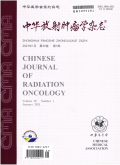FDG PET-CT代谢参数对NSCLC放疗患者预后影响
Prognostic significance of FDG PET/CT parameters in patients with non-small cell lung cancer of radiotherapy
摘要目的 探讨疗前FDG PET-CT获得的NSCLC原发灶代谢参数及其临床因素对NSCLC放疗患者预后影响. 方法 回顾分析2007—2013年间在本院首程放疗前行PET-CT的170例NSCLC患者资料,分析其临床因素、原发灶SUVmax、SUVmean、MTV 及 TLG 等参数与患者预后关系. 应用Kaplan-Meier法计算生存率并Logrank检验和单因素分析,应用Cox模型进行多因素分析.结果5年样本数为48例,5年OS 率为24. 7%,单因素生存分析示年龄、N 分期、cTNM 分期、肿瘤大小、SUVmax、MTV及TLG为预后影响因素( P=0.001~0. 040). 多因素分析显示年龄、原发灶MTV为总生存期预后影响因素( P=0. 016、0. 005). 结论 年龄、N分期、临床TNM分期、肿瘤大小、SUVmax、MTV及TLG是影响NSCLC放疗患者预后因素,其中疗前患者年龄及原发灶MTV是总生存期的预后影响因素.
更多相关知识
abstractsObjective To investigate the metabolic parameters of primary lesions of non-small cell lung cancer ( NSCLC) obtained by 18 F-FDG PET/CT and their prognostic values in patients with NSCLC who underwent radiotherapy. Methods The clinical data of 170 NSCLC patients who underwent PET/CT scan before the first course of radiotherapy in Cancer Hospital, Chinese Academy of Medical Sciences, from January 2007 to December 2013 were analyzed retrospectively. The prognostic values of clinical factors, maximum standard uptake value ( SUVmax ) standard uptake value ( SUVmean ) , metabolic tumour volume ( MTV) , and total lesion glycolysis ( TLG ) were analyzed. The Kaplan-Meier method was applied for univariate survival analysis, the log-rank test was applied to compare the survival rate between groups, and the Cox proportional hazards regression was applied for multivariate survival analysis;P<0. 05 was considered statistically significant . The number of patients who received the follow-up visit at 5 years were 48 . Results The 5-year overall survival was 24. 7%. The univariate analysis showed that age, N stage, clinical TNM stage, tumor size, SUVmax , MTV, and TLG were the prognostic factors in NSCLC patients who underwent radiotherapy ( P=0. 001-0. 040) . The Cox proportional hazards regression analysis of the above parameters showed that age and MTV of the primary lesion were the independent prognostic factors for overall survival (P=0. 016,0. 005). Conclusions Age, N stage, clinical TNM stage, tumor size, SUVmax, MTV, and TLG are the prognostic factors in NSCLC patients undergoing radiotherapy, while age and MTV of the primary lesion are the independent prognostic factors.
More相关知识
- 浏览219
- 被引5
- 下载100


相似文献
- 中文期刊
- 外文期刊
- 学位论文
- 会议论文



 换一批
换一批 换一批
换一批



